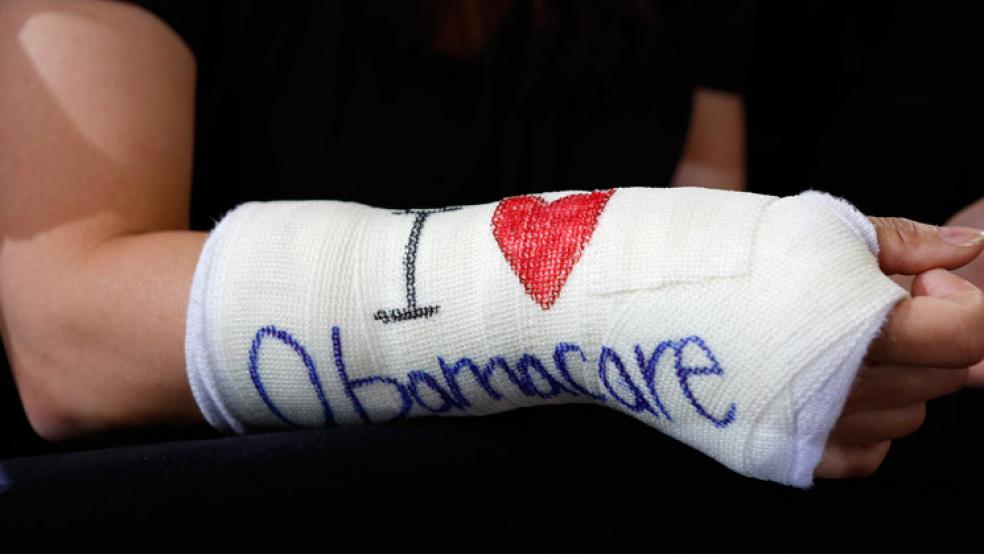Hillary Clinton upended the delicate consensus on health care policy in the Democratic Party’s upper echelons this week.
Clinton reportedly came out against the so-called “Cadillac tax,” adding her voice to a bipartisan call ranging from Bernie Sanders to conservative House Republicans, from business to labor, to repeal the excise tax on high-cost employer health plans (40 percent on every dollar above $10,200 a year for individuals and $27,500 a year for families).
The elite pushback has been intense.
The Washington Post editorial board said Clinton “canceled out any claim to responsibility” on health care, and suggested she only made the decision to appease unions, which generally have good employer health care plans. One hundred and one center-left economists signed onto a letter to Congress opposing any change to the Cadillac tax without some alternative “that would more effectively curtail cost growth” in employer health plans. And Sarah Kliff at Vox presented the prevailing opinion that labor and business hate the law “because it’s working.”
Related: Democrats Begin the Long, Tortuous Retreat from Obamacare
Kliff bases her opinion on a study of 2014 employer health benefits by the Kaiser Family Foundation, showing that 13 percent of large companies have already downgraded their benefit packages to avoid the tax, and 53 percent have researched the possibility. The tax doesn’t take effect until 2018.
The Kaiser survey certainly shows that employers are giving worse health plans to their employees. But that doesn’t actually show the Cadillac tax is working, at least not fully, because the tax has two goals. One is to lower overall health costs by creating more monetary pain for high-cost plans, and nudging businesses and individuals to be smarter health care shoppers. The other is to boost worker pay.
The theory here is that, as employers lower health care spending, the savings get plowed into higher wages, equalizing overall compensation. Economic studies have typically looked at this the other way around, finding a relationship between falling wages and rising health care costs. “In the long run if insurance costs rise, they will take a toll on wages,” said Paul Starr of Princeton University. “The reverse should be true — in the long run, but in the short run maybe not.”
Related: An Obamacare Change to Medicare Is Backfiring
The problem with this reverse-engineering is that it’s highly theoretical. There’s no study, for example, showing that the large companies that already downgraded employee health plans also boosted wages. It would be hard to know even how to design such an experiment, given all the factors that go into wages. “I don't think there is any real research to document or refute that claim,” said Harold Pollack of the University of Chicago, one of the academics who signed the pro-Cadillac tax letter. “It is well-grounded in economic principles but difficult to empirically test.”
The theory can bump up against realities of the labor market, such as the low labor force participation rate we’re seeing today. Companies may not have to transfer benefit cuts to higher wages to retain workers, who might have trouble finding new employment. That’s especially true if most companies make the same cuts, making other job prospects less attractive. And if there’s no pressure to return profits to workers, the last 40 years have demonstrated that businesses won’t.
“I am dubious that in the current economic context that the things being done to lower premiums is resulting in higher wages to offset them,” said Larry Mishel of the labor-allied Economic Policy Institute (EPI). “No evidence speaks to all this.”
Related: 8 Benefits Questions to Ask This Open Enrollment Season
Josh Bivens of EPI even questioned whether economic studies showing a textbook trade-off between health benefits and wages give the full picture. “Most of the public data don’t have an employee co-pay to their premium,” Bivens said, suggesting that without this, you don’t get the real value of the health plan. A 2013 study by Darren Lubotsky and Craig Olson of the University of Illinois at Urbana-Champaign included employee co-pay data in studying Illinois teachers between 1991-2008, and it found “no evidence that changes in teachers’ salaries respond to changes in insurance cost.”
Interestingly, an earlier version of the same paper did find such a relationship, suggesting how hard it is to wring the truth out of the data. “It does shake me that we can’t find it really robustly with good studies,” Bivens said. “The theory turns to dust when trying to find the trade-off.”
There are other problems with the excise tax. Even if workers do get a wage boost, the bulk of it would go to paying higher out-of-pocket costs. “Only if people forego doctor visits do they get any benefit,” Bivens said. That cuts against a central goal of Obamacare itself: to increase preventive care and arrest costly health problems before they metastasize. People cut back on health spending in random and often self-destructive ways. Instead of squeezing out wasteful spending, the Cadillac tax could eliminate useful spending that makes people healthier.
Related: ‘Cadillac Tax’ Looms for Larger Employer Health Plans
Moreover, hitting “high-cost health care plans” doesn’t necessarily target lavish ones. States have considerable variation in health costs, and the tax disproportionately affects those high-cost states even though plans there pay for less coverage. Older Americans are more likely to have a high-cost plan simply because of allowable actuarial modeling. The size of a firm also matters: Smaller companies have less bargaining power to get a better price for their health plans.
In theory, the Cadillac tax should decrease health care utilization, making individuals more discerning in their choices. But health care is nearly an impossible market in which to be a good shopper, with its opaque costs and tendency for people to listen to their doctors. As EPI’s Elise Gould notes in a paper on the subject, “Forcing Americans to pay a higher share of health costs will not induce them to shop around and compare prices when they are experiencing chest pains or their child is suffering from an asthma attack.”
Gould’s paper finds that increased cost-sharing proposals hit patients who need the most care. Indeed, the Kaiser Family Foundation identifies cost-sharing as the real driver in health spending over the past few years. While overall health inflation has been contained to some degree, deductibles are skyrocketing. This is driving down usage of medical care, including medically necessary treatment: “a penny-wise, pound-foolish result,” Gould writes.
Related: Americans Have Insurance but Can’t Afford to Use It
The Cadillac tax raises $91 billion over the next decade, and Clinton wants to offset the cost of repeal, though she hasn’t specified a funding source. Elites want to preserve the tax to “bend the cost curve” of health spending and shift compensation to wages. But they hang their hopes on large assumptions about the labor and health care markets, and if the goal is better systems in both, they may miss the mark.
“Where the United States stands out on health care isn’t on the utilization side. We stand out on stuff being expensive,” Josh Bivens said. “We should focus on prices and not quantities. And the excise tax is all about ratcheting down the quantity of health care.”






